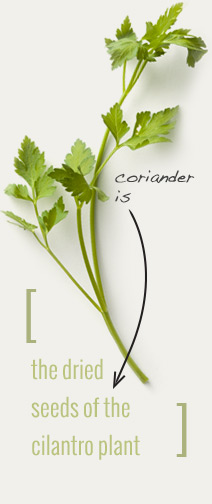Coriander
Coraindrum Sativum
01.
Overview
usable plant parts
seeds, leaves (
cilantro), essential oil
flavor notes
a sweet mellow and warm flavor with a hint of orange
coriander varieties available @
Monterey Bay Herb Company
please note: clicking links above
will bring you to the individual product pages
culinary uses
Coriander is a staple in Indian cuisine. It is added whole or ground to chutneys, pickling spice mixtures and is frequently used to season chicken and pork. Often, coriander seeds are combined with cumin seeds and fried "dry" before being powdered.
Though coriander is the dried, brown seeds of the
cilantro plant it doesn't taste anything like the herb. In fact, the seeds taste like burnt orange when toasted but are mildly sweet when ground as a spice.
Coriander should be added late in cooking—just minutes before your dish is completed—since prolonged cooking will cause the flavor to dissipate. Coriander can help provide flavorful balance between sweet and pungent tastes. Since coriander can be used in great quantity it can save your homemade spice blends wherein you might have been too generous with a pungent item. To rescue your mix you can simply add double the amount of coriander as done with the opposing spice to regain balance.

02.
Traditional Plant Usage
love-bug potions
This spice gets its name from
koris, the Greek word for "bed bug". Reputedly, this is because the pest gives off an aroma similar to the leaves of the mother plant from which the spice is harvested — cilantro.
Biblical and historical mentions suggest this is a spice used since ancient times. The Hebrews adopted coriander from their former masters, the Egyptians, who used it as a spice and perfume. The Egyptians considered coriander such a basic necessity that seeds have been found in several Pharaohs' tombs, presumably to prevent indigestion in the afterlife.
The Romans allegedly used coriander as a meat perservative and to flavor their breads, and legend suggests it was the Roman legions that introduced coriander to Britain. Later it was used frequently in Medieval Europe perhaps to mask the taste of rotten meat; and Charlemagne had it grown in the imperial gardens in AD 812.
Though widely used for many centuries it gradually went out of favor in western cooking. It is now found more readily in Asian food where it has thousands of years of history of use as both leaf and seed. In India, coriander became an ingredient in curry spice blends. It pairs well with fish and pork dishes; but can also accent apples and other fruit. It complements both sweet and savory dishes.
Perhaps most interestingly it
was used is used in making love potions. You can still find enterprising love enthusiasts concocting mixtures of olive oil, red pepper, mustard powder, red wine, coriander, thyme and hazelnuts as a dressing for salads; or others taking the less complicated route of adding crushed coriander to red wine and letting the brew steep for a few days. It is possible coriander gained its amatory reputation because it was referred to as an aphrodisac in the Arabian classic
One Thousand and One Nights. Others claim it increases blood flow and arousal. We will let you be the judge of its modern-day efficacy. If your alchemy efforts fail, coriander still tastes wonderful and can be chewed to eliminate bad breath.
Additionally the essential oil of coriander is used in perfumes and in liquors. Please note: the essential oil of coriander should not be taken internally.
03.
Habitat / Range
farming and processing
Coriander is native to Europe and Asia, but can be grown in temperate zones all over the world. It grows up to 20 inches tall and has small upper leaves used for flavoring food (
cilantro). The plant has a strong aromatic effect. It also grows white and pink flowers that produce seeds.
Harvesting occurs when the seeds turn from green to light brown. Plants are cut and are withered for a few days. The edible part of the seed is loosened from the inedbile chaff surrounding it by a process called threshing. The seeds are then dried fully, sifted and packed.
for educational purposes only
This information has not been evaluated by the Food and Drug Administration.
This information is not intended to diagnose, treat, cure, or prevent any disease.